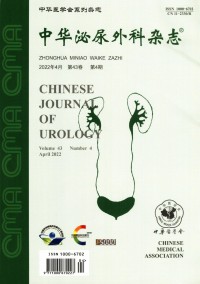不同膀胱颈分离技术在机器人辅助腹腔镜前列腺癌根治术中的临床应用
Q4 Medicine
引用次数: 0
摘要
目的探讨不同膀胱颈分离方法在机器人辅助腹腔镜前列腺癌根治术(RARP)中的临床效果。方法回顾性分析2014年10月至2018年10月在我中心进行的机器人辅助腹腔镜前列腺癌根治术(RARP)的资料。所有手术都由同一位泌尿科医生进行。根据膀胱颈分离方法的不同,将所有患者分为四组。A组常规向前剥离法(500例):在膀胱颈前部12点钟处切开1cm,切断逼尿肌,切开膀胱颈。B组膀胱颈T形切口(133例):明确膀胱与前列腺交界处,膀胱颈前壁T形切口。C组采用传统膀胱颈T形切口剥脱术治疗(81例)。D组外侧入路(36例):沿膀胱颈外侧和前列腺内侧后韧带分离并与先前建立的Dirichlet间隙融合。对患者的一般数据进行统计分析。A、B、C和D组的平均年龄分别为63岁(62.5至67岁)、65岁(61至68岁)、66岁(64.5至70.5岁)和62岁(59.5至66.5岁),4组的年龄差异无统计学意义(P>0.05);PSA分别为13 ng/ml(9.0~22 ng/ml)、7.4 ng/ml(6.4~26.0 ng/ml),6.2 ng/ml(5.3~27.0 ng/ml)和14 ng/ml(8.4~21.0 ng/ml)(P>0.05);穿刺Gleason评分分别为6.9(5-9)、7(6-12)、9(8-16)、10(6-18)(P>0.05);前列腺体积分别为66ml(42~78ml)、70ml(50~89ml)、53ml(43~72ml)、80ml(68~92ml)(P>0.05);体重指数≤25kg/m2的比例分别为60.0%、63.9%、39.1%、42.0%和>25kg/m2,分别为40%、36.1%、60.9%和58.0%(P>0.05)。结果750例RARP手术全部成功,无一例转为开放手术。A、B、C和D组的手术时间分别为100分钟(70~120分钟)、89分钟(70至95分钟)、105分钟(80至127分钟)和110分钟(90至130分钟)(P>0.05);吻合时间分别为20.5min(18.0~25.0min)、16.1min(10.7~17.3min)、25.4min(18.9~27.0min)和28.5min(21.0~32.0min),B组吻合时间明显短于其他组(P<0.05)。近端边缘阳性率:A组40例(8.0%),B组0例,C组6例(7.3%),D组3例(8.3%),边缘切口低阳性率B组(P<0.05),结论以上四种方法在机器人辅助腹腔镜前列腺根治术中分离膀胱颈是安全可行的,可有效避免输尿管损伤。每种方法都可以在术后6个月内获得更好的尿液控制率。T形膀胱颈后近端切缘阳性率在四组中最低。关键词:前列腺肿瘤;机器人手术系统;膀胱颈分离本文章由计算机程序翻译,如有差异,请以英文原文为准。
Clinical application of different bladder neck separation techniques in robot-assisted laparoscopic radical prostatectomy
Objective
To investigate the clinical effect of different bladder neck separation methods in robot-assisted laparoscopic radical prostatectomy (RARP).
Methods
To retrospective analysis the data of robot-assisted laparoscopic radical prostatectomy (RARP)in our center from October, 2014 to October, 2018. All operations were performed by the same urologist. According to the different methods of bladder neck separationAccording to the different methods of bladder neck separation, all the patients were divided into four groups. Group A routine forward peeling method (500 cases): Make a 1cm incision at 12 o'clock on the front of the bladder neck, cut off the detrusor muscle and cut the bladder neck. Group B T-cut incision of the bladder neck (133 cases): identify the bladder and prostate Junction, T-shaped incision of the anterior wall of the bladder neck. Group C conventional stripping method combined with T-shaped incision of the bladder neck (81 cases). Group D lateral approach (36 cases): along the lateral side of the bladder neck and the medial posterior ligament of the prostate is separated and merges with the previously established Dirichlet space. The general data of patients were analyzed statistically.The average ages of groups A, B, C, and D were 63 years (62.5 to 67 years), 65 years (61 to 68 years), 66 years (64.5 to 70.5 years), and 62 years (59.5 to 66.5 years)respectively, there was no statistical significance difference in terms of age in 4 groups(P>0.05); PSA is 13 ng/ml(9.0 to 22 ng/ml), 7.4 ng/ml(6.4 to 26.0 ng/ml), 6.2 ng/ml(5.3 to 27.0 ng/ml), 14ng/ml(8.4 to 21.0 ng/ml), (P>0.05); Gleason scores of puncture were 6.9(5 to 9), 7(6 to 12), 9(8 to 16), 10(6 to 18), (P>0.05); the prostate volume was 66ml(42 to 78 ml), 70ml(50 to 89 ml), 53ml (43 to 72 ml), 80 ml (68 to 92 ml), (P>0.05); the proportions of body mass index ≤25 kg/m2 were 60.0%, 63.9%, 39.1%, 42.0%, and>25 kg/m2 were 40%, 36.1%, 60.9%, and 58.0%, respectively, (P>0.05). The operation time, bleeding volume, anastomosis time, postoperative hospital stay, postoperative complications, positive rate of proximal incision margin, urinary indwelling time, and urinary control rate in the four groups analyzed.
Results
All 750 RARP operations were successful, and none were converted to open.The operation time of groups A, B, C, and D were 100 min(70 to 120 min), 89 min(70 to 95 min), 105 min(80 to 127 min), and 110 min(90 to 130 min), (P>0.05); anastomosis time was 20.5 min (18.0 to 25.0 min)、16.1min (10.7 to 17.3 min)、25.4 min (18.9 to 27.0 min)、and 28.5 min (21.0 to 32.0 min), the anastomosis time in group B was significantly shorter than other groups (P 0.05). Postoperative complications: Anastomotic fistula and ureteral injury occurred in 3 cases in group A, and no serious complications occurred in the other 3 groups. Proximal marginal positive rate: 40 cases (8.0%) in group A, 0 cases in group B, 6 cases (7.3%) in group C, 3 cases (8.3%) in group D, and low positive rate of margin incision in group B(P 0.05). Six-month postoperative urine control rate: 381 cases (75.2%) in group A, 102 cases (76.9%) in group B, 61 (75.4%) in group C, and 27 (73.8%) in group D, (P>0.05).
Conclusions
The above four method of bladder neck separation during robot-assisted laparoscopic radical prostatectomy is safe and feasible, which can effectively avoid ureteral damage. Each method can obtain better urine control within six months after surgery rate. The positive rate of proximal incision margin after T-shaped bladder neck was lowest among four groups.
Key words:
Prostatic neoplasms; Robotic surgery system; Bladder neck separation
求助全文
通过发布文献求助,成功后即可免费获取论文全文。
去求助
来源期刊

中华泌尿外科杂志
Medicine-Nephrology
CiteScore
0.10
自引率
0.00%
发文量
14180
期刊介绍:
Chinese Journal of Urology (monthly) was founded in 1980. It is a publicly issued academic journal supervised by the China Association for Science and Technology and sponsored by the Chinese Medical Association. It mainly publishes original research papers, reviews and comments in this field. This journal mainly reports on the latest scientific research results and clinical diagnosis and treatment experience in the professional field of urology at home and abroad, as well as basic theoretical research results closely related to clinical practice.
The journal has columns such as treatises, abstracts of treatises, experimental studies, case reports, experience exchanges, reviews, reviews, lectures, etc.
Chinese Journal of Urology has been included in well-known databases such as Peking University Journal (Chinese Journal of Humanities and Social Sciences), CSCD Chinese Science Citation Database Source Journal (including extended version), and also included in American Chemical Abstracts (CA). The journal has been rated as a quality journal by the Association for Science and Technology and as an excellent journal by the Chinese Medical Association.
 求助内容:
求助内容: 应助结果提醒方式:
应助结果提醒方式:


